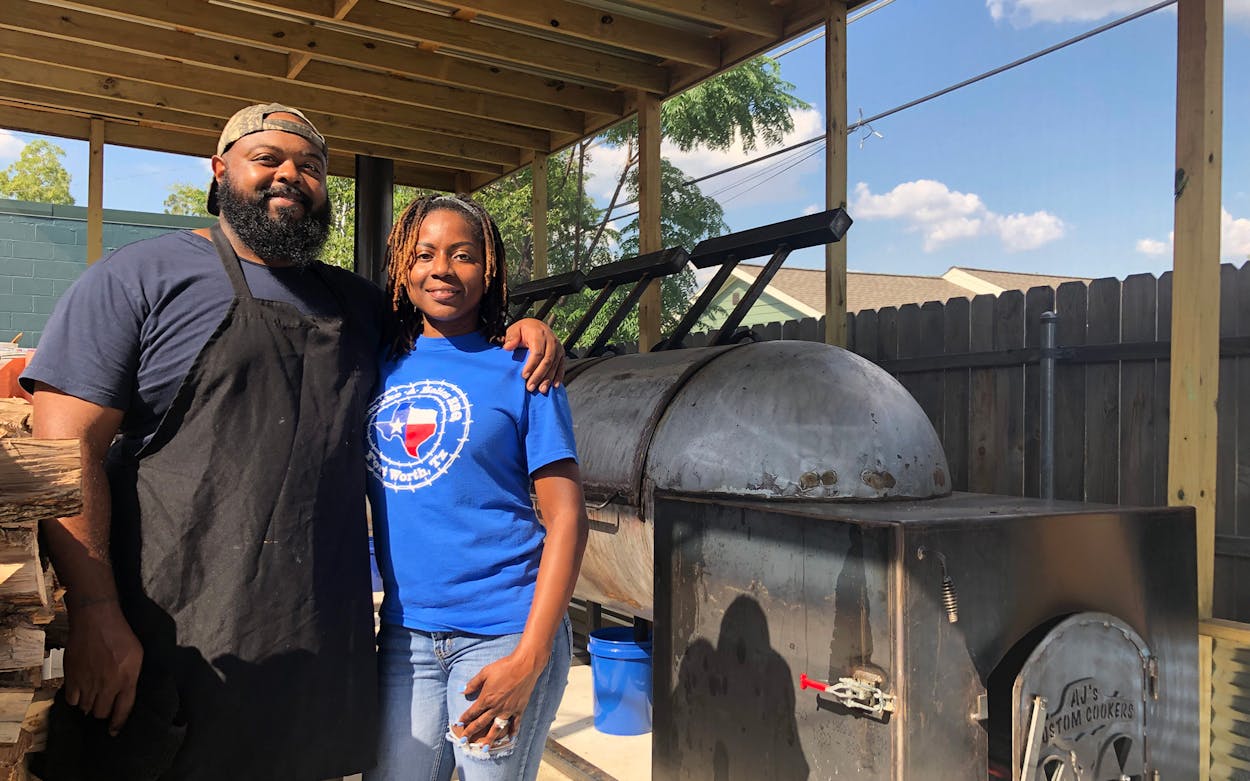The scale of barbecue output required to run a restaurant is a whole lot different from what the average backyard cook deals with on a weekend. It might seem like an entirely different process, but other than bigger smokers with many more briskets than your family probably needs, the cooking principles remain the same. For the special Ultimate Guide to BBQ issue we recently published, we talked with four pitmasters from across the state to gather some nuggets of wisdom that they’ve learned by smoking meat day in and day out. They provided tips on everything from wood selection to schedule making, and even reading the wind.
Pitmaster:
Derrick Walker, of Smoke-A-Holics BBQ, in Fort Worth
Get the right equipment: Don’t think you’re getting restaurant-quality barbecue on a grill. I started with a $20 red grill that comes out of a box, and I’d cook four racks of ribs on that at a time. It can be done, but they weren’t nearly as good as what I cook now. If you want to get serious, get a wood-fired smoker.
Keep the meat moist: Add some sort of liquid to the meat—use a mop sauce or a spritz—every thirty to forty minutes. I use fifty-fifty apple juice and apple cider vinegar and spritz it on everything. Don’t worry about losing heat from checking on the meat that often. It won’t extend your cook that long. Raise the lid, spray the meat, and close the lid.
Wrap the meat to finish cooking: For ribs, when you get the color you want, wrap them in foil and cook them for another forty minutes. For brisket, get the color you’re looking for, and get the temp to 160–170 before wrapping. For brisket, I prefer butcher paper instead of foil; your bark will suffer with foil.
Pitmaster:
Aaron Franklin, of Franklin Barbecue, in Austin
Prepare a timeline: Create a cook schedule, working backward from when you want to serve the barbecue, and write it down the day before. Make a checklist of ingredients and equipment you think you’ll need.
Meat mise en place: Split the wood, trim the meat, and get your seasonings mixed the day before you plan to cook. You don’t want to rush through the trimming and seasoning in the morning because you slept late or the fire wouldn’t start. And what if it’s raining in the morning? Nobody wants to split wood in the rain.
Build a big fire: In the firebox, start with a bigger fire than you think you need and let it burn down to a good coal bed. Don’t spend the whole cook nursing along a small fire. And whatever you do, get the fire started and the pit temperature where you want it before putting the meat in the smoker.
Pitmaster:
Emma Mendoza, of Evie Mae’s Pit Barbeque, in Wolfforth
Focus on the placement of the meat in the cooker: After some experience with your cooker, you’ll understand the hot and cold spots inside. Use those to your advantage. I like to put the big briskets in the hot spot to get them moving along in their cook faster, and the smaller ones go in the cool spots.
Start a fire with olive oil: We use butcher paper soaked in beef fat to start the fires at the restaurant. Not everyone has beef fat lying around at home, but take some butcher paper and soak it in olive oil to get a similar result. Olive oil is a little more expensive than vegetable oil, but I swear it makes a better fire.
Work with the wind: We can’t move our smokers at the restaurant, but most backyard cooks can. If the wind is strong, or even if there’s just a breeze, turn the smoker around so the wind flows into the firebox. If it’s sitting the other way, the backflow of wind through the smoker can be a problem.
Pitmaster:
Don Nguyen, of Khói Barbecue, in Houston
Don’t choke off the fire: Control the temperature through the amount of fuel you use instead of choking it down when the smoker gets too hot. When we first started we were lazy; we’d stuff the firebox full of logs, then choke off the oxygen to keep the smoker temp low. We got dirty smoke. Now we just add wood as we need it to raise the temperature and keep the firebox door open to let the air flow in.
Start cooking earlier than you think you should: Meat needs to rest, especially large pieces of barbecue. It takes hours for a brisket to cool down, and you don’t want to serve it hot off the smoker. The meat can also stay hot in a cooler for a very long time. For our pop-ups, we have rested briskets for more than eighteen hours. You’ll save yourself a lot of stress when the brisket is already done in a cooler when the party starts.
Don’t buy your wood at the grocery store: Search Craigslist to find a wood supplier, or ask the supplier of your local barbecue joint. Lots of them sell wood by the quarter cord, and that wood is about 10 percent the price of what you buy bagged up in the store. If you need wood chunks, spend $100 on an electric miter saw. If you cook barbecue often, it will pay for itself pretty quickly.
- More About:
- Black BBQ








